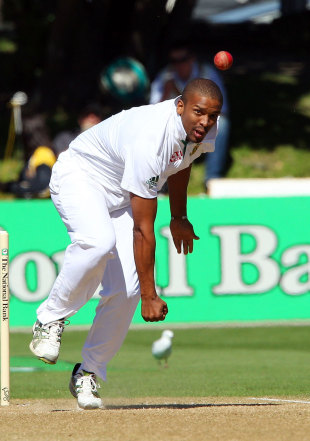
Photo: Getty Images
The Vernon Philander Effect.
‘Faster than a speeding bullet, more powerful than a locomotive, able to leap tall buildings in a single bound. The infant of Krypton is now the Man of Steel: Superman!’
SuperVern? Not quite, although Philander is re-writing the cricket fast bowling records at quite a pace.
Having coached Vernon at the Cape Cobras for the last couple of years and against him for the previous four seasons when I was with the Titans, I’ve been asked this question a lot in the last summer …
What makes him such a potent strike force?
Before we get there, let’s go back in time six months to September 2011 … If someone had asked a cricket fan anywhere in the world who Vernon Philander was there is a high probability the response would have been … Vernon who ?
In that same September, Philander travelled unheralded to India with the Cape Cobras to play in the CLT20 competition, he returned to South Africa at the end of the competition to no fanfare. Not a blip on the radar.
By December 2012 all who follow test cricket around the world knew Vernon Philander, how short is three months in a players career?
From relative obscurity to front page.
He was selected to play against Australia at Newlands on a spicy wicket and promptly went about dismantling the fragile Australian batting line up. This theme continued through the short Australian series and into the Sri Lankan, bar the performance at Kingsmead, where South Africa didn’t turn up. The South African quicks with Philander now at the forefront ripped through Sri Lanka’s inability to play on bouncy, seaming wickets.
To top off a historic summer for Philander, he departed for New Zealand to end the southern hemisphere season and continued his ‘Superman’ performances, leaving his vaunted fast bowling partners, Dale Steyn and Morne Morkel in the wings.
Into the pages of cricket history … one of the fastest bowlers to 30 wickets, in all of four Test matches: 4 five wicket hauls and ten wickets in a match, back to back six wicket hauls against NZ, the joint second fastest bowler to fifty test wickets … of all time! The fastest for over a century and on better batting wickets. The records continue to tumble.
It hasn’t always been that way, Vernon Philanders journey to the front page of cricket news has been circuitous. The opportunity to take the new ball for South Africa was earnt over the best part of 8 seasons from making his first class debut in 2003 for the Cape Cobras.
Vernon had previously had a short and not particularly successful debut with South Africa in 2007 on a one day series tour of Ireland , rightly or wrongly, he returned from it without his reputation enhanced.
There were questions about Philander’s attitude and physical conditioning and it seemed as if he was destined to be one of South African crickets nearly men. A couple of appearances, a shirt and a cap and not much else … to return to the hinterlands of domestic cricket.
His selection at the time as a short form player was more about opportunity than based on consistent numbers. It looked like one of those curious, uniquely South African selections where the national selectors pick a young player, under pressure to bring through promising young cricketers of colour. Those of us close to the coal face, day in, day out, knew that Vernon’s game was better suited to the long form, Test cricket.
Vernon’s isn’t quick in comparison to a Dale Steyn, but he has a good change up in pace, he has late away swing to the right hander and a genuine inswinger for the LBW/Bowled dismissal and the nick off to the left hander. Ask Mike Hussey.
So what really makes Vernon unique? Vernon’s strategic game plan is based on simplicity, superb control and the patience to explore and examine a batters game, probing for errors in technique and judgement.
His line of wicket to wicket bowling, with a line so tight on off stump and just outside that every ball is a strict examination of a batters judgement of when to play and when to leave.
Here is the difference that separates Philander from other bowlers, the ability to create doubt through this unerring accuracy and subtle skills, asking the batter, ball after ball, of when to play and when to leave.
In the Cobras dressing room after a win, the team song for Vernon goes … ‘Ooh, Ah, Vern McGrath, I say Ooh , Ah, Vern McGrath’ to which Vernon has to promptly dispose of his beer. The McGrath bit is an acknowledgement to the virtues of skill, control and patience exemplified by the great Glenn McGrath and although there are hundreds of wickets and many inches in height between the two bowlers, there is this commonality of high skill and unerring accuracy.
So who is Philander? Vernon’s background is Cape Town northern suburbs, it’s a far cry from the manicured lawns of the southern suburbs and the privileged traditional schools which were for many years the breeding grounds of Western Provinces’ white cricketers.
The northern suburbs are more working class and blue collar, it’s a longer journey physically and metaphorically to Newlands and cricket success. As timing would have it, Vernon was born as one of those young South Africans who knew little of apartheid outside of the history books and was marked in the new dispensation of cricket unity in South Africa as a hugely promising school boy cricketer, selected quickly for senior Western Province honours.
Let us hope that Vernon’s success is long lived, that he has the focus and discipline, on and off the field to become a worthy successor to Makhaya Ntini in carrying the hopes and aspirations of South Africa’s previously disadvantaged cricket communities.
Back To Cricket Players From The Vernon Philander Effect

About Richard Pybus
I'm Richard Pybus, I've coached Pakistan, Bangladesh, Middlesex, Titans and the Cape Cobras in South Africa and the goal of this site is to help you to play winning cricket.
